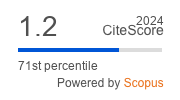A Communicative Image of Social Network Audience: Psycholinguistic Perpective
Keywords:
virtual identity, communicative portrait of a social network audience, psycholinguistics of social networks, social network communities, social networks, net-centricity.Abstract
In the paper, anthropocentrism is proved to be the basis of psycholinguistic research of Internet social communities; net-centricity is viewed as a cognitive basis of network communications; as exemplified by social networks VKontakte, YouTube, Odnoklassniki, and Facebook communicative portraits of audiences in psycholinguistic dimension are proposed. It was determined, that social network communities are becoming a platform for interpersonal communications, producing Web-waves, mobilizing communities for actions in reality. Social network communities have the following characteristics: identification of personality based on the principle “Tell me, to what social network you belong, and I will tell you who you are”; shift from vertical to horizontal dimension of communications; segmentation of audiences, individualization of communications and actualization of the role of opinion leaders in each network; producing Web-waves which trigger a cognitive pattern “interest – participation in communication – making a decision”; possibility of monitoring and analysis of communications effectiveness; change of status of an information consumer. New subject of research (social networks) stipulated appearing of a new field of psycholinguistic research – psycholinguistics of social networks communications, tasked to: identify the characteristics of language functioning in new technological conditions; study the psychological basis of producing and functioning of discourses as the reflection of new communicative patterns, focused on collective authorship in reproduction of contents; analyse the formation of personal and collective identity in discourse practices of social network communities.
References
- Arestova, O., Babanin, L., Voyskunskiy, A. (). Motivatciya polsovateley Internet [The Internet:
influence on personality] [Electronic resource] Retrieved 2.05.2013 from: http: //www.relarn.ru:
8082/conf/conf97/10.html, 09.03.2014 - Babayeva, Y., Voyskunskiy, A., Smislova, O. (2000). Internet: vosdeystvie na lichnost [The
Internet: influence on personality]. Gumanitarnye Issledovaniya v Internete, 11−39. - Gichkina, A. Osobennosti formirovaniya obrasa seba I obrasa drugogo v Internet-communicatsii
[Characteristics of formation of a self-image and an image of the other in Internet communication]
[Electronic resource] Retrieved 2.05.2013 from: http: //flogiston.ru/projects/ articles/refinf.shtml,
09.03.2014 - Nosov, N. (2000). Virtualnaya psihologiya [Virtual Psychology]. Мoscow: Agraf.
- Castells, M. (1996). The Rise of the Network Society. The Information Age: Economy, Society
and Culture. Vol. 1. Cambridge, MA; Oxford, UK: Blackwell. - Castells, M. (2001). The Internet Galaxy. Reflections on the Internet, Business and Society.
Oxford: Oxford UP. - Сhelovek kak subyekt mediapsikhologii [Human as a Subject of Media Psychology]. (2011).
Moscow: Moscow State University. - Danet, B. (2004). Text as Mask: Gender, Play and Performance on the Internet in Cyberspace
2.0: Revisiting Computer-Mediated Communication and Community. London; New Delhi: Sage
Publications, 129−158. - Dyson, E. (1997). Release 2.0: A Design for Living in the Digital Age. London: Viking,
281−286. - Ostwald, M. J. (1997). Virtual Urban Futures in Virtual Politics. Identity and Community in
Cyberspace / M. J. Ostwald. Boston: SAGE Publications, 125−144. - Rodino, M. Breaking out of Binaries: Reconceptualizing Gender and its Relationship to
Language in Computer-Mediated Communication [Electronic resource] / Retrieved 2.05.2013 from:
http: //www. ascusc.org/jcmc/vol3/issue3/rodino.html. - Rosen, J. Top Ten Ideas of ‘04: News Turns from a Lectureto a Conversation [Electronic
resource] Retrieved 9.03.2014 from: http: //archive.pressthink.org›2004/12/28/ tptn04_opsc.html,
09.03.2014 - Shane, B. We Media: How audiences are shaping the future of news and information
[Electronic resource]. Retrieved 9.03.2014 from: http: //flickertracks.com›blog/
images/we_media.pdf,09.03.2014 - Suler, J. E-Mail Relationships. Psychology of Cyberspace [Electronic resource] Retrieved
2.05.2013 from : http: //www1rider.edu/~suler/psycyber.html,09.03.2014 - Toffler, A. The Third Wave [Electronic resource] Retrieved 9.03.2014 from: http:
//fenopy.se›…toffler a the third wave…fb2, 09.03.2014







 Creative Commons «Attribution» 4.0
Creative Commons «Attribution» 4.0